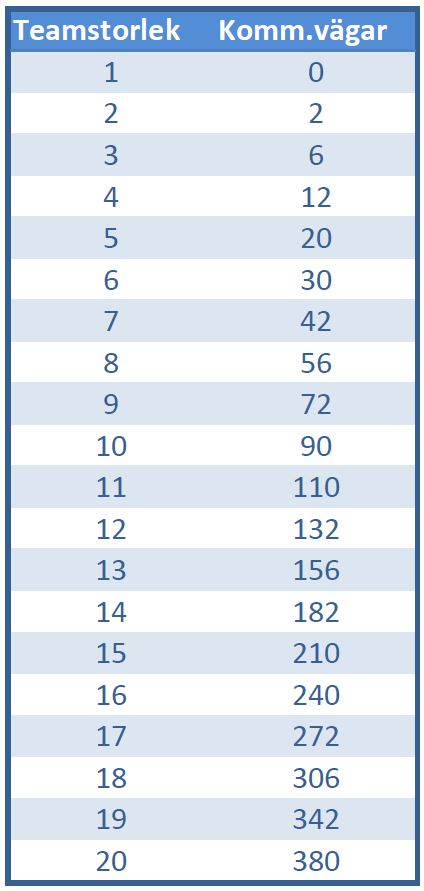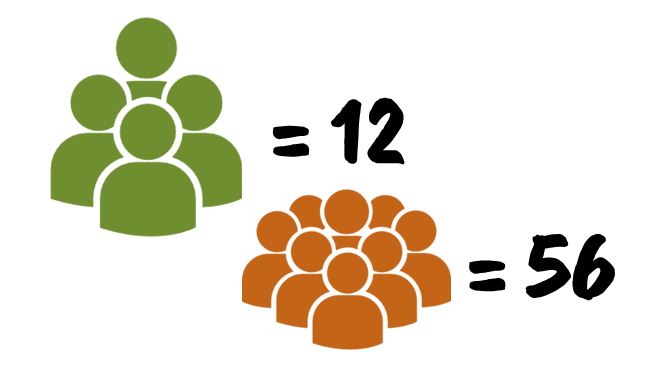Varför är kommunikation svårare i större team?
Jag ser då och då problem som beror på att ett team är för stort. När ett team blir för stort kan olika konstiga situationer uppstå. En sådan konstig situation är att ett stort team som får problem med produktiviteten kan få lite dåligt rykte (kanske oförtjänt) i en organisation. Det händer då att organisationens missnöje gör att saker som att inrätta specialteam (hjälteteam) eller att byta ut teammedlemmar börjar diskuteras.
Det är mänskligt att tycka att ett stort team borde ha högre produktivitet och bättre möjligheter än mindre team att hantera olika störningar, men något som ibland glöms bort är att det stora teamet i och med sin storlek också fått ett antal extra problem att brottas med:
- Större team har fler teammedlemmar och varje teammedlem för sig har olika tankesätt, preferenser, beteenden och attityder som andra teammelemmar ska upptäcka, förstå, vänja sig vid och hantera på daglig basis. Även om det går bra så är det inte konstigt om det tar längre tid.
- I stora team är det stor risk att vissa teammedlemmar bara kommunincerar med vissa andra teammedlemmar så att det stora teamet därmed börjat falla sönder i subteam. Det slutar helt enkelt vara ett team.
- Antalet kommunikationsvägar ökar drastiskt i ett stort team jämfört med ett mindre team.
Formeln för det ser ut så här:

K är antalet kommunikationsvägar och m är antalet teammedlemmar.
Varje gång någon i teamet vill säga något, har en fråga eller en fundering, så brukar det ske kommunikation. Om antalet möjliga kommunikationsvägar är stort så tar det helt enkelt mer tid att kommunicera och risken ökar då också för att det ska bli fel i kommunikationen. Alternativet är förstås att varje person inte kommunicerar med alla andra, vilket in teär konstigt alls, men då har vi i värsta fall inte längre någon fungerande informationsspriodning i teamet. Teamet är på väg att få subteam.

Som tabellen visar har ett team med två personer bara två kommunikationsvägar.
A pratar med B och B pratar med A. No biggie. Med tre teammedlemmar har det plötsligt blivit sex kommunikationsvägar. Med fem teammedlemmar är antalet kommunikationsvägar uppe i 20 och sedan blir det bara värre.
Problemet är kanske inte så lätt att se till vardags, men blir plötsligt dramatiskt tydligt med hjälp av grafen här nedanför. Ett team med till exempel 12 personer kommer att ha utmaningar i kommunikationen

Vad säger andra om det här?
Dean Leffingwell skriver i boken Scaling Software Agility att
”Agile teams depend on constant, informal communication and collaboration.”
Ajdå. Om agila team är beroende av konstant kommunikation så bådar det inte gott att ha ett agilt team med till exempel tolv personer i.
Jim Highsmith skriver i Agile Project Management att
”When management has eliminated the impediments to success, it trusts the team to deliver on its commitments. The rest is up to the team.”
Jaha? Så om teamstorleken i sig är ett hinder så är det i så fall ledningens jobb att hjälpa till att undanröja det hindret innan teamet kan förväntas leverera i nivå med sina åtaganden.
Sammanfattningsvis
Teamstorlekar runt 3-4-5-6 personer är inte något som någon bara har hittat på för att det låter bra. Det finns bra skäl till att inte ha för stora team och det är något som är bra om alla vet när det är dags att diskutera teamstrukturer.
Lycka till!
/Björn
